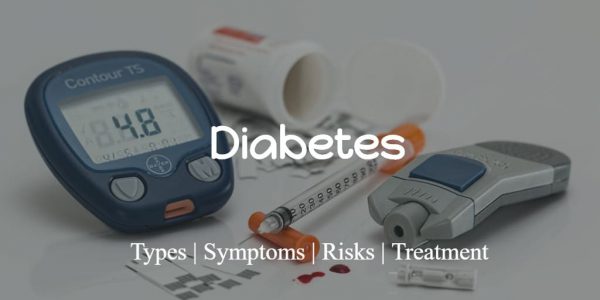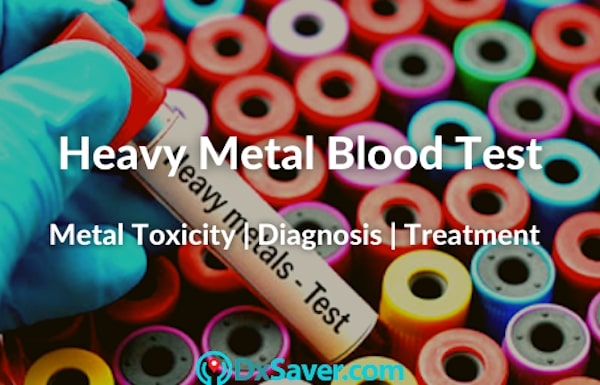
Heavy metals are naturally bound in our foods, medicine, and even in water. A heavy metal blood test is done in a panel or individual test that is done to detect any excessive exposure to specific heavy metals.
The human body naturally contains some heavy metals like zinc, iron, and copper in the bloodstream, in small amounts. They are necessary for regular body function, but they can be alarmingly serious if they are found in toxic amounts. So, we highly recommended taking periodic heavy metal toxicity test if your workspace is surrounded by heavy metals, or if you experience the symptoms of heavy metal poisoning and suspect that you may have been exposed to one or more heavy metals.
- Heavy Metal Blood Test Cost
- Comprehensive Heavy Metal Blood Test
- What is Heavy Metal Poisoning?
- What are the Signs & Symptoms of Heavy Metal Toxicity?
- Signs of Lead poisoning
- Symptoms of Mercury Poisoning
- Symptoms of Arsenic Poisoning
- Symptoms of Cadmium Poisoning
- How is the Heavy Metal test done?
- Is There Any Preparation Required before the Test?
- Are there any Risks in the Test?
- What does the Test Result Mean?
- How to Treat Heavy Metal Poisoning?
- Heavy Metal Detox
- How to Prevent Heavy Metals Poisoning?
- Providers Locations
For our readers, who are very much interested in knowing the Heavy Metal Blood test cost beforehand, we would like to begin with that section.
Heavy Metal Blood Test Cost
Heavy Metal Blood Test cost ranges between $174 and $289 in different labs and facilities across the U.S. No prior appointment is required. Compare the price, order your test online and visit the nearest lab during lab business hours. Complete the procedure and get the results in your email in 2 to 3 business days.
The following table shows the Heavy Metal Blood Test cost at 2 of our partner laboratories (CLIA – Certified) network located across the U.S.
Name of our Partner Labs | Book Online |
HealthLabs
| Offer Price$289 |
Personal Testing Lab
| Offer Price$174 |
Comprehensive Heavy Metal Testing – (Urine Sample Test)
Comprehensive Heavy Metal Testing cost ranges between $549 and $724 in different labs and facilities across the U.S. No prior appointment is required. Compare the price, order your test online and visit the nearest lab during lab business hours. Complete the procedure and get the results in your email in 2 to 3 business days.
The following table shows the Comprehensive Heavy Metal Testing cost at 2 of our partner laboratories (CLIA – Certified) network located across the U.S.
Name of our Partner Labs | Book Online |
HealthLabs
| Offer Price$549 |
Personal Testing Lab
| Offer Price$724 |
Heavy Metal Blood Test With Insurance
Most health insurance policies in the U.S. do not cover the cost of the Heavy Metal Blood Test. However, the coverage offered by private health insurance companies and national health insurance programs like Medicare and Medicaid varies widely. So we recommend you to check the coverage of your health insurance plan with the insurance company before getting tested for testosterone levels.
Our Heavy Metal Blood Test testing providers do not accept any kind of health insurance plan. But, on request, they can provide you with an itemized receipt containing all the details like the name and code of the test, and CPT code which is necessary for insurance reimbursement purposes.
What is Heavy Metal Poisoning?
Consumption or inhaling of metals in huge amounts is toxic to human nature. Most people unknowingly consume heavy metals like mercury or lead in some form of food packing tins, fish, and other work environments. If the excess metal substances are not eliminated or detoxed from the body in time, they can lead to serious health problems like
- Infertility
- Anemia
- Psychological changes
- Irreversible brain problems
- Organ damage
- Bone marrow
- Kidney damage
- Difficulties with thinking and memory issues.
Heavy metal poisoning can occur due to the excessive amount of the particular heavy metal in our system. They can get into your system in different ways, like inhaling them, eating them, or by coming into skin contact.
A heavy metal blood test is a group/panel of tests that is conducted to detect and monitor the levels of potentially harmful metals in the blood. The most commonly reported metal poisoning is for lead, mercury, arsenic, and cadmium. Metals that are rarely tested for include copper, zinc, aluminum, and thallium.
What are the Signs & Symptoms of Metal Toxicity/Poisoning?
Heavy metals can enter your body in multiple ways. You might consume them in the food you eat or absorb them through your skin, for example, food, air, or water pollution, as well as medicine, food containers with improper coating, industrial exposure, or lead-based paint.
However, in the United States, heavy metal poisoning is very rare. It only occurs when you’ve been exposed to a significant amount of heavy metal, usually over a long period of time, occasional exposure will not cause any toxic reaction.
General Symptoms of Metal Toxicity
The general symptoms of heavy metal poisoning/toxicity are diarrhea, nausea, abdominal pain, vomiting, shortness of breath, tingling in your hands and feet, chills, and weakness.
However, you can experience multiple uncommon symptoms due to heavy metal poisoning. They can be classified according to the type of metal exposed. The following are some of the major metal elements and their toxicity symptoms.
Lead Poisoning
Lead and organic lead are seen in various components of our life. In most cases, they are seen in commercial and industrial applications, such as storage batteries, paints, bearing alloys, plastics (PVC pipes), insecticides, and ceramics.
Lead is also used to be used in pipes and drains in homes, and they are ingested through flaking, weathering, and dust. Lead poisoning may also occur due to the inhalation of automobile exhausts as they are composed of dust containing lead.
Lead can be found in
- Plumbing
- Fuel additives
- Ammunition
- PVC plastics
- X-Ray shielding
- Kohl cosmetics
- Industrial construction work, radiator repair, or smelter operations
- Foreign digestive remedies, calcium products, Surma, kajal, or progressive hair dyes
- High levels of lead-based paint (Some household might be painted with such material)
Signs of Lead Poisoning
Metal toxicity like lead poisoning can lead to severe health adversities. They can affect the thyroid, bones, and kidneys if the lead is exposed at a large amount. Childhood heavy metal poisoning is common in children below the age of 6 years, as they come in contact with inanimate objects like paint with their hands and take their hands to their mouth, causing heavy metal poisoning in children.
Symptoms of Lead Heavy Metal Poisoning are
- Insomnia/sleep problems
- Constipation
- Loss of appetite
- Memory loss
- Muscle paralysis
- Neuropathy
- Gastrointestinal disturbance
- Anemia and tiredness
- Loss of developmental skills in children
- Ingestion of large quantities may lead to death
If you suspect that you are exposed to lead poisoning and experience the above symptoms, it is highly recommended to take a heavy Metal Blood test. The Heavy Metal Blood Test shows the amount of the toxic metal that exists in the blood. Generally, if the blood result of lead toxicity is 25 grams per deciliter, then it is more than the normal level.
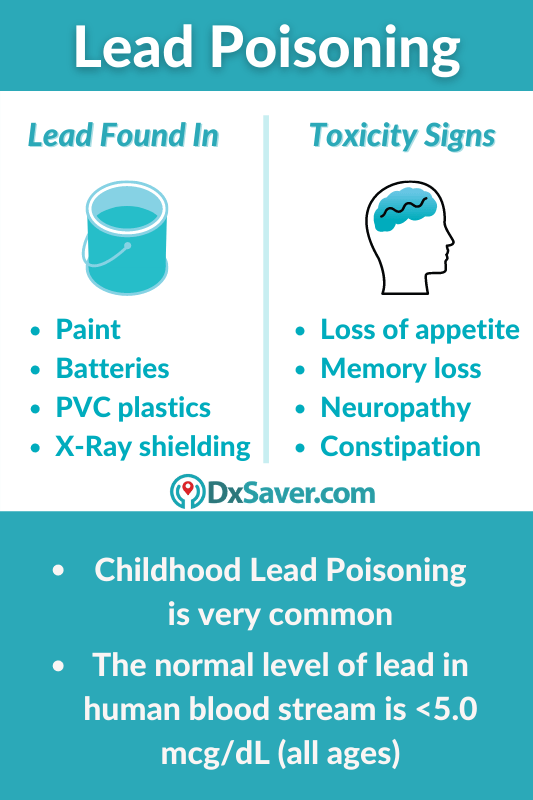
Mercury Poisoning
Mercury is found as one of the commonly reported heavy metal toxicity cases. The use of mercury can be seen in the paper industry and mining industries. Rain and aquatic supplies like lake fishes contain mercury in small amounts. When the fish gets contaminated or laid uncooked for a long time, the mercury levels increase drastically, leading to mercury poisoning. However, mercury compounds are completely avoided in the end consumer goods, homes with old paints may contain some.
Mercury metal can be found in thermometers, dental amalgams, and childhood vaccines. Mercury poisoning generally occurs due to inhalation. The primary targets are the brain and kidneys. The coal-fired power plants emit an estimated 75 tons of mercury each year making it one of the general population exposure to mercury.
Mercury is found in
- Mining – producing or transporting mercury
- Contaminated fish/water
- Mirrors, X-ray machines, Incandescent lights, and Vacuum pumps
Symptoms of Mercury Poisoning
You often don’t get exposed to mercury in large amounts unless you are working at a mining site or manufacturing industry that uses mercury as their raw material. So, the most common nonindustrial cause of mercury poisoning is the consumption of methyl mercury-contaminated fish. Organic mercury poisoning is best detected in blood than in a urine specimen, as this form of mercury is located mainly in the blood’s RBCs (Red Blood Cells).
Mercury poisoning affects the Central Nervous system (CNS), and most of the symptoms are exhibited as neurological disorders.
Mercury toxicity symptoms are
- Trouble walking
- Lack of coordination
- Muscle weakness
- Hearing and speech difficulties
- Nerve damage in your hands/face
- Changes in vision
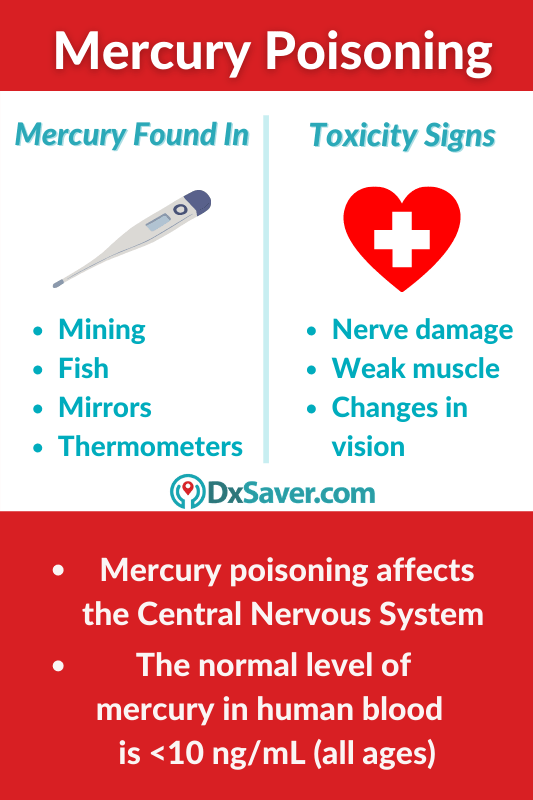
Cadmium Poisoning
Cadmium heavy metal is used in the lead and zinc mining sites. Cadmium is exposed in fertilizers, batteries, cigarettes, and PVC plastics. Aquatic reservoirs that contain shellfish has a high probability of containing cadmium,
Cadmium is found in
- Inhaling cigarette smoke
- Industrial areas of processing or smelting
- Welding alloys that have – cadmium or using silver solders
Symptoms of Cadmium Poisoning
Cadmium poisoning can lead to severe health issues such as damages to the liver, placenta, lungs, brain, kidneys, and bones. Cadmium toxicity symptoms are –
- Fever
- Muscle pain
- Breathing problems
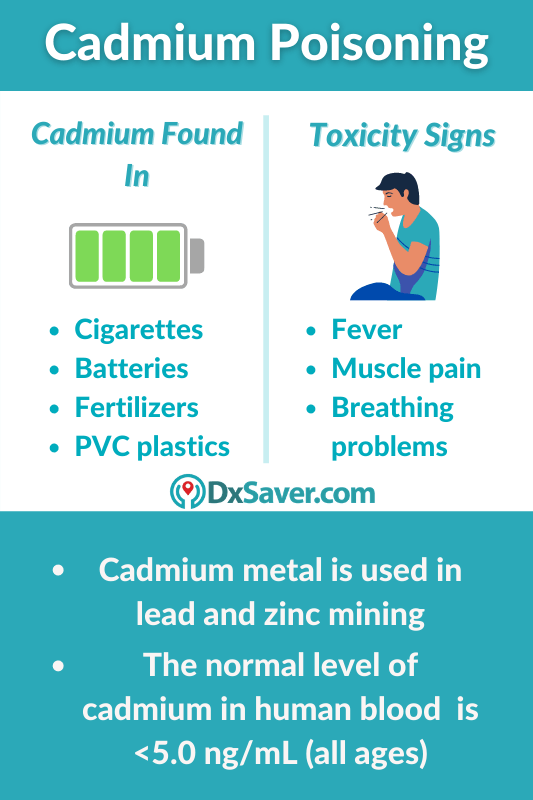
Arsenic Poisoning
Heavy metal testing panels include arsenic metal for screening. Arsenic poisoning is one of the common causes of acute poisoning through heavy metals. Arsenic toxicity occurs when the metal enters due to the smelting of copper, zinc, and lead components. They are also released in the manufacturing of certain chemicals like pesticides.
Arsenic metal is found in older paints, rat poisoning components, fungicides, and wood preservatives.
Arsenic, when ingested into human anatomy, will lead to damage to the body’s blood, central nervous system (CNS), and digestive system. Arsenic toxicity is harmful to the kidneys and skin.
Arsenic is found in
- Hazardous waste site
- Insecticides, pesticides, or herbicides
- Contaminated seafood/water
- Area that has high levels of rocks, water, and soil in its environment
Symptoms of Arsenic Poisoning
Arsenic is used in the production of pesticides and in some industrial uses. The following are the symptoms of Arsenic poisoning
- Nausea, vomiting, and diarrhea
- Red or swollen skin
- Spots on your skin
- Unusual heart rhythm
- Muscle cramps
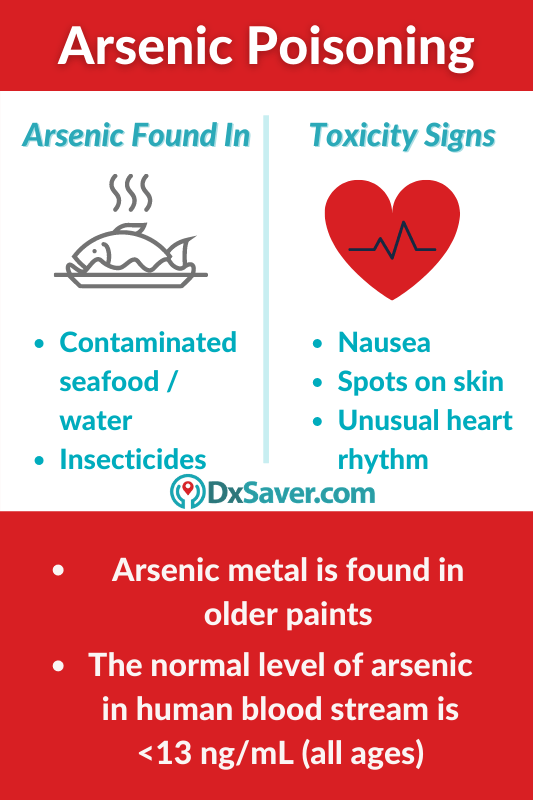
Is There Any Preparation Required before the Test?
Before taking the Heavy Metal Toxicity Test you should not eat any aquatic foods for 48 hours before sample collection, as it may influence the test results. Other than this, you can continue with your regular lifestyle activities.
What does the Test Result Mean?
If your heavy metal blood test shows a high level of metal, it indicates that you are exposed to heavy metals at some point in time. You will be asked to completely avoid exposure to that metal. In the case of little to no results of reduction in the metal levels in the blood, then your health care provider may recommend chelation therapy. Chelation therapy is used to treat and remove the excess metals from your body using a pill or an injection.
If your heavy metal blood testing results are low, and you still have the symptoms of exposure, your health care provider will likely order more tests to know the exact level of the blood components. Some heavy metals tend to exit the system in a while and they don’t usually stay in the bloodstream very long.
Reference values apply to all ages, except for lead, classified by age as follows.
Arsenic Metal Normal Levels
All ages: <13 ng/mL
Lead Metal Normal Levels
All ages: <5.0 mcg/dL
Critical values –
Pediatrics (< or =15 years): > or =20.0 mcg/dL
Adults (> or =16 years): > or =70.0 mcg/dL
Cadmium Metal Normal Levels
All ages: <5.0 ng/mL
Mercury Metal Normal Levels
All ages: <10 ng/mL
Heavy Metal Detox
If your heavy metal blood test shows high levels, you will need to completely avoid exposure to that metal to Heavy Metal Detox. Detoxing the excess heavy metals needs to be put in action by changing the lifestyle habits to avoid serious health consequences.
If you are working in a factory or construction site you will be asked not to work for a certain period of time until you are fully detoxed from heavy metals. In the case of organic consumption like fish or other sources, it is highly advisable to stop certain diets and take foods that help in heavy metal detox.
Diet for heavy metal detox
Some foods can help the process of detoxifying the heavy metal out of your system more quickly. Intake of foods high in vitamins and minerals can have protective effects for those exposed to heavy metals.
Heavy metal detox foods to eat are:
- Garlic
- Wild blueberries
- Lemon water
- Curry
- Green tea
- Tomatoes
- Barley grass juice powder
Foods to avoid for heavy metal poisoning
If you are exposed to heavy metal poisoning, the following are some foods that needs to be avoided to detox the heavy metals efficiently.
- Rice
- Alcohol
- Nonorganic foods & Processed foods
- High mercury-containing fishes (large and long-living fish)
How to Prevent Heavy Metals Poisoning?
In heavy metal poisoning, lead poisoning is a very serious type. Some children under the age of 6 can get exposed to lead by touching surfaces with lead and putting their hands in their mouth, need to be tested for lead because they have a higher risk for lead poisoning. Even low levels of lead poisoning can cause severe brain damage as the brain is developing at the pediatric age and can result in behavioral disorders.
Old houses are painted with paints that have large lead composition. Children living in older houses are at an even higher risk because their household environments may contain more lead.
These are a few steps you can take to reduce your exposure to heavy metal poisoning:
- Ensure your workplaces follows OSHA guidelines.
- Limit your consumption of fish known to contain higher levels of mercury.
- Check the quality of paint and the home quality if it was built before 1978.
- Only purchase supplements and spices from trusted, high-quality sources.
Providers Locations
Heavy Metal Testing can be done in any of the following states either at the provider’s location. To know the Heavy Metal test cost in these locations, check the first section of this article.
- Alabama
- Arizona
- Arkansas
- California
- Colorado
- Connecticut
- Delaware
- Florida
- Hawaii
- Georgia
- Idaho
- Illinois
- Indiana
- Iowa
- Kansas
- Kentucky
- Louisiana
- Maine
- Michigan
- Minnesota
- Mississippi
- Missouri
- Montana
- Nebraska
- Nevada
- New Hampshire
- New Mexico
- North Carolina
- North Dakota
- Oklahoma
- Oregon
- Pennsylvania
- Puerto Rico
- South Carolina
- South Dakota
- Tennessee
- Texas
- Utah
- Vermont
- Virginia
- Washington
- West Virginia
- Wisconsin
- Wyoming
Frequently Asked Questions
Will insurance cover my heavy metal testing cost?
No. Generally providers do not accept the insurance in order to ensure your privacy. However, they will provide you a receipt for insurance reimbursement purposes.
How should I book my appointment for heavy metal testing?
You can choose the most suitable provider from above and make an appointment by following the instructions mentioned by them.
Can I cancel my lab test order?
Yes, you can cancel your lab test order anytime before your testing. A refund will be initiated after deducting the cancellation fee. However, cancellation is at the discretion of the provider.
Do the providers offer result interpretations?
Yes, few providers may provide doctor consultation who will take you through the results and provide clarification if needed.
How do I receive my report?
In order to ensure your privacy, the test report will be mailed to you by the provider.
Other topics you may be interested in:-
- Signs and Symptoms of Oral Syphilis
- STD Testing Cost in the US
- Testosterone Test Cost in the US
- Cost of HbA1c, Hemoglobin Test in the US
- Vitamin D Testing in the US
- Homocysteine Test Near Me
- Importance of CA 125 Testing & Ovarian Cancer in Women
- IGF-1 Test Cost
- Stool Culture Test Cost
- Alpha-fetoprotein, AFP Test Cost in the US
- Is Itching a Symptom of STD?
- Anti-TPO Test
- Estrogen Test Cost
- Anti-aging Testing Cost in the US
- Herpes Vs. HPV: Differences, Symptoms, and Testing Cost
- C-Peptide Normal Levels, Test Results & Treatment
- Importance of Progesterone & Fertility Testing
- Types of STDs that cannot be cured
- Oral STDs: Names, Symptoms, Treatment and Testing Cost
- Types of STDs That Cause Mouth Sores Symptoms in Men and Women






